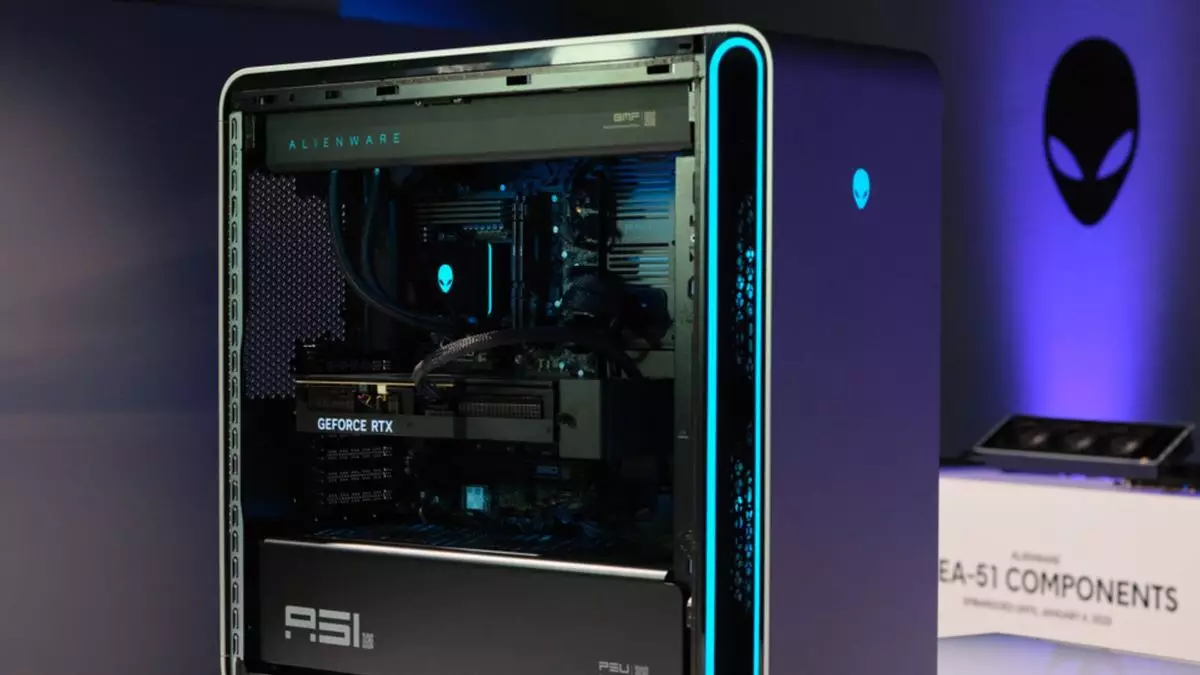Alienware has long been a name synonymous with high-end gaming PCs, renowned for their striking aesthetics and powerful performance. As we entered CES this year, the anticipation surrounding Alienware’s Area-51 desktop rig hinted at a transformative upgrade in its design philosophy: full upgradeability. However, like an enticing mirage, this promise is tempered with caveats that give us pause.
The reveal of the new Area-51 rig was heralded with excitement, offering gamers a chance for custom upgrades without having to resort to a complete overhaul of their machines. Unfortunately, the new ‘fully upgradeable’ assertion carries a significant asterisk. The introduction of the AlienFX board cable conversion kit for $35 raises eyebrows—why should consumers pay extra to fully unlock the features touted by the brand? This convoluted pricing structure leaves a bittersweet taste for those hoping to invest in their gaming future.
Cables and Compatibility: A Hidden Cost
At first glance, the new conversion kit, which includes essential wiring components like a power switch and USB dongle extension, may seem minor in significance. Yet, it embodies broader issues with the perceived upgrade slope for customers. This kit is touted as crucial for making the Area-51 compatible with third-party motherboards, a feature that should ideally be standard for a rig marketed on its upgrade potential. The necessity of a specialized cable for connectivity reveals the dissonance between Alienware’s innovative branding and practical considerations.
Moreover, the bind of power supply requirements with the ATX12VO motherboard just complicates matters. Gamers seeking to enhance their setup must juggle multiple costs alongside their original investment. It isn’t simply a purchase; it becomes a matter of crafting a complex ecosystem of upgrades, which can render the originally appealing offer, daunting. This meticulousness is not what gamers have come to expect from a brand that traditionally promised streamlined experiences.
The Aesthetics and Performance Promise
Despite the rocky landscape of upgradeability, the new Area-51 rigs do boast a stunning design and bolstered performance metrics that are hard to ignore. Alienware has proudly declared its new model as “the most quiet, coolest running, and highest performance desktop” to date. The superior thermal management and airflow mechanism—classified as positive pressure—marks a significant step forward for the brand. This innovation prevents dust accumulation and retains optimal thermal environments, showing that Alienware still has a finger on the pulse of necessary hardware advancements.
Furthermore, enthusiasts giddy with anticipation can delve into the specifications equipped with the latest RTX 50 series graphics cards. Running cooler and quieter provides a backdrop for a more immersive gaming experience—a selling point that can’t be overlooked. However, as compelling as these features may be, they are overshadowed by the restrictive motherboard upgrade limitations that sully the narrative of advancement.
The Mixed Messages of Modularity
One might argue that the mere existence of modularity—albeit restricted—is an achievement in itself for Alienware’s historically fixed architecture. While GPU, RAM, and SSD upgrades are free from similar restrictions, showcasing QR codes next to parts for instruction further enhances the user experience. Yet, we cannot ignore the frustrations stemming from the paradoxical nature of this experience: In several ways, the new design speaks to progressive advancement, while crucial components still remain shrouded in old-school constrictions.
Alienware’s efforts to create visually striking and operationally sound machines are evident, and yet the constraints placed on motherboard flexibility reveal an inconsistency in messaging. The gameplay architecture of this new Area-51 model feels like a jump forward in theory but falters in practical application. This duality of progress and limitation invites skepticism rather than excitement, as users grapple with the reality of navigating Alienware’s version of upgradeability.
While gaming rig options continue to evolve, navigating the intricate pathways toward customization and performance enhancement will require scrutiny. Enthusiasts must establish expectations grounded in both the allure of ambitious design and the reality of hardware limitations.


Leave a Reply